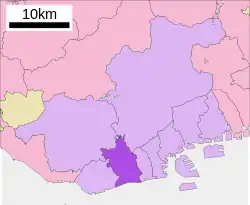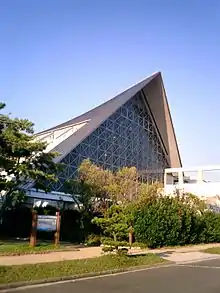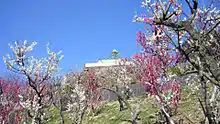Suma-ku, Kobe
Suma (須磨区, Suma-ku) is one of 9 wards of Kobe, Japan. As of February 1, 2012, it has an area of 30.0 km², and a population of 166,324, with 71,745 households.
Suma-ku
須磨区 | |
|---|---|
Ward of Kobe | |
 View of Suma Beach from Mount Sumaura Amusement Park | |
 Location of Suma-ku in Kobe | |
 Suma-ku | |
| Coordinates: 34°39′01″N 135°07′50″E | |
| Country | Japan |
| Region | Kinki (Kansai) |
| Prefecture | Hyogo |
| City | Kobe |
| Area | |
| • Total | 30.00 km2 (11.58 sq mi) |
| Population (February 1, 2012) | |
| • Total | 166,324 |
| • Density | 5,544.13/km2 (14,359.2/sq mi) |
| Time zone | UTC+9 (Japan Standard Time) |
| Phone number | 078-731-4341 |
| Address | 1-1-1Nakashima-cho, Suma-ku, Kobe-shi, Hyogo-ken, 654-8570 |
| Website | www |
There is a white sandy beach in this ward, which attracts tourists to the Kansai region for sunbathing and popular events during the summer. The beach is also a location in the Japanese literary classics Ise Monogatari, Genji Monogatari, and Heike Monogatari. Suma is often referred to as an utamakura or meisho, and is mentioned frequently in waka, and in Noh, Kabuki and Bunraku dramas.
Nowadays, people mainly live in Myodani, Myohoji and other northern parts of the ward.[1]
Myōdani Station is a major station in western Kobe.

Suma Temple

Tainohata Yakuyoke Hachimangu

Suma Aquarium at Suma beach

Mount Sumaura Park
Places of interest
- Suma Rikyu Park
- Suma Public Aquarium
Notable people
- Shintaro Ishihara - Governor of Tokyo
- Yone Suzuki - businesswoman, lived in Suma-ku before 1927
- Nobu Jo - social worker, founder of a suicide prevention campaign in Suma[2]
References
- "神戸市須磨区:区の概要".
- "A Signboard for Suicides in Japan". The Missionary Review. 44: 308–310. April 1921.
This article is issued from Wikipedia. The text is licensed under Creative Commons - Attribution - Sharealike. Additional terms may apply for the media files.